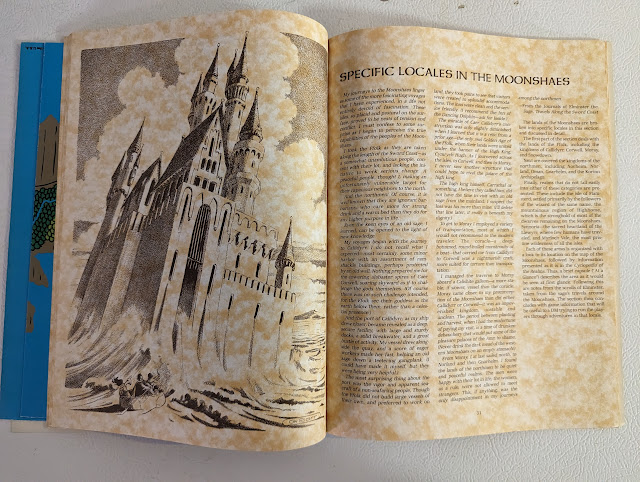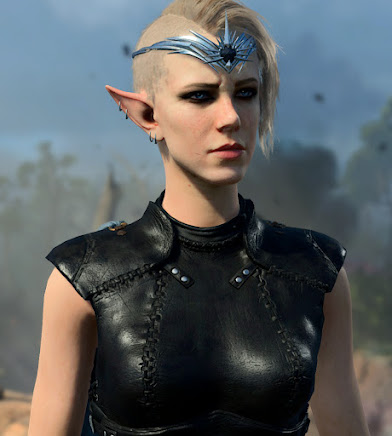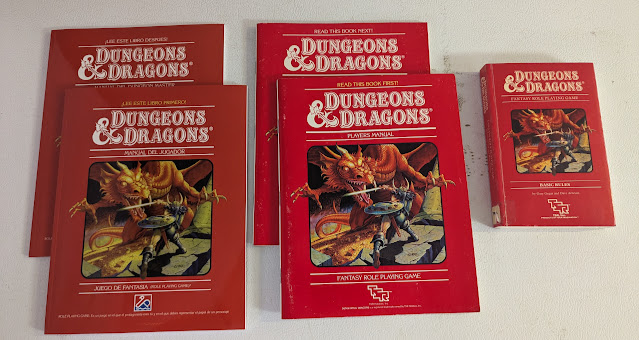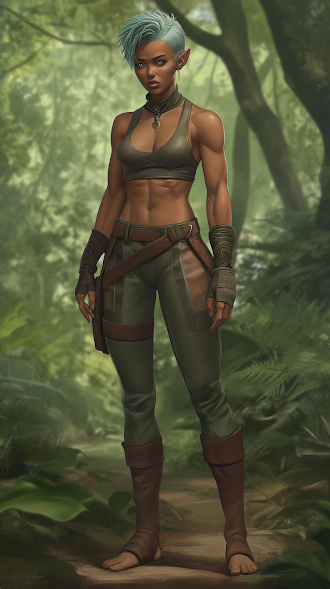Up first will be a book I bought years ago (from Castle Perilous!) because I knew if I ever "did the Realms," this is where I would start.
by Douglas Niles, Print and PDF. 64 pages, full color, dual-sided map. 1987.
For this review, I considering both my original version and the PDF from DriveThruRPG.
Ok, why am I starting with a supplement and one not even from Ed Greenwood himself? Simple, the Moonshae islands were always that one bit of the Forgotten Realms I was really fascinated by. It was also where I knew I would set my native Realms in. It felt close enough to the Irish and Celtic myths I loved while still being "D&D" enough. I knew enough of the history of this and the Moonshae novels by Douglas Niles to make this worthwhile to get. But I am getting ahead of myself here.
In the AD&D 1st Edition Players Handbook, Gary Gygax had this to say about Druids:
"Druids can be visualized as medieval cousins of what the ancient Celtic sect of Druids would have become had it survived the Roman conquest." - PHB, p. 21
The Moonshae Isles can be viewed as the British Isles if the Celts, the Britons, and all the rest had thrown Rome out in 55 AD. We know that Douglas Niles was working on a Celtic-themed set of books and a new campaign setting in the mid-80s. He brought over his collection of islands, and Ed Greenwood tossed out what had been his Moonshae (or whatever was there) and used Niles' for the publication version of the Forgotten Realms. This book acts as an overview and a Gazetteer.
The book is divided into three major sections, plus an Introduction and Appendices.
Introduction
This covers a bit of fiction that connects it to the Moonshae novels, particularly Darkwalker on Moonshae. I started the novel a couple of times but never got through it. You don't need to know anything about it, though, to use this book.
Moonshae Overview
This covers the Moonshae Isles and the sorts of characters and Characters, as well as the folk and Fflok, you will meet there. It makes a very good case for this to be the starting point of the adventures. Since, to my very limited knowledge, this is the western most point on the Forgotten Realms maps at this time. You can travel east and see the entire world.
The races are AD&D standard, but I already feel some differences here from, say, Greyhawk. There is a good section on common conflicts. This appeals to me since one on my favorite themes to deal with in games is the waning of Paganism and the rise of Monotheism in Western Europe. The Moonshae has this theme baked in with its Druids vs. Clerics and Ffolk vs. the Northmen.
Humans are divided up into the previously mentioned Fflok (think British pagans) and the Northmen (think Norse/Viking raider pagans). There is an uneasy truce here now. I can't wait to see if this boils over or if they take a page from our world and just settle down. One of the reasons you are reading this in English now. This is illustrated with a map of the political borders, which Elminster tells us are constantly in flux in the book.
We get another map of trade routes within the islands and to the Sword Coast mainland. Some tables on weather (it's a lot like Chicago to be honest) and lots of great random encounter tables.
The Moonshae book effectively makes the "low level" adventuring interesting where a Giant Stag is big opponent, but you could also see goblins or a faerie dragon. The Celts book for AD&D 2nd Edition would do the same thing very well. Honestly that book could be used with the Moonshae with no problem whatsoever.
Deities of the Moonshaes
I will give Niles and TSR credit, they didn't stick a narrowly defined idea of what a god might be. The main Goddess of the Moonshaes is The Earthmother. We are told she is an aspect of the Goddess Chauntea who the rest of the Realms sees as an agricultural goddess. The Ffolk, though, do not see her like that. To them she is The Goddess. Embracing a bit of the revisionist views of British Paganism but I like it, and more to the point it works well here. If Gygax can say what he did about Druids above, then this logically follows. The Goddess has three children. The Leviathan, a gargantuan whale, Kamerynn, a large unicorn, and the Pack, a pack of wolves. All have been endowed with special qualities by the Earthmother and are her eyes and ears in these lands. There is also evil here in the form of Kazgoroth, the Beast. Who looks a bit like a wingless dragon.
Specific Locales of the Moonshaes
This covers a dozen or so locations. Parallels can be drawn from many of these to locales in British and Irish myth and legend. And honestly, that is fine. It made figuring out where to start my grand adventure even easier. I mean I could be wrong but Callidyrr is our stand-in for Camelot, Corwell is Cornwall, Moray is like a smaller Ireland or a larger Ilse of Man, and so on. Now there are some interesting additions. What if the Vikings, when raiding, decided to set up in Scotland or Ulster and kicked everyone else out? Well, you might have had something like Norland. I imagine the AD&D 2nd Ed Vikings Campaign book would be useful here as the Celts one was for the southern islands.
Other areas are detailed like Myrloch, the large inland lake/sea in Gwynneth in the south and Synnoria, the land of the Llewyrr Elves. There is even Flamsterd, an island of Magic-users. You know I am heading back there sometime.
The Appendices
Appendix A covers some campaign themes for the Moonshaes, not that I need any more at this point! But it does include a note on how to bring in the module N4 Treasure Hunt into the Moonshaes, which is great really.
Appendix B gives us some unique items of the Moonshaes.
Elminster's Notes
There are a lot of those here. If you were to take them out, there only be about 32 pages. But they set the tone of the book and the land well. We are new here but not new to D&D so Elminster's eyes are a perfect substitute for our own.
The maps look great and should be compatible with the clear hex grid from the Forgotten Realms set.
A much more pleasurable work than when I first read it way back in the early 1990s. The whole "Ffolk" thing with the two "f"s bugged me, but I got over it. You could build an entire campaign and never leave these islands. Which is not what I am going to do since there is so much more out there.
Sinéad's Perspective
So, I am going to look at the people and places of this product through the eyes of my bard Sinéad. Much like Greenwood does with Elminster, she will be the eyes and ears in which I see the Realms. But I am not going to give you long-winded journal entries. That's Ed's and Elminster's thing.
Choosing the Moonshaes as my first product and choosing the Moonshaes as the home of Sinéad makes a lot of sense together. These lands feel familiar to me. I have read hundreds of tales of Celts and Celtic heroes and monsters. Nearly as many tales of the Norse and Vikings. Tons on the Rise, Fall, and Rise again of the very particular British form of British Paganism. I have never been here, but I know it well. Much like Sinéad, I am leaving this place. Maybe it is too early, but certainly, I will have to come back here.
Final Thoughts
I am not sure if it was planned or not, but this does feel like a perfect place to start your adventures in the Forgotten Realms. By today's standards, the book is a bit light on the crunchy game stuff. No new spells really or specialized sub-classes. But that is fine; the fluff more than makes up for it all.



















